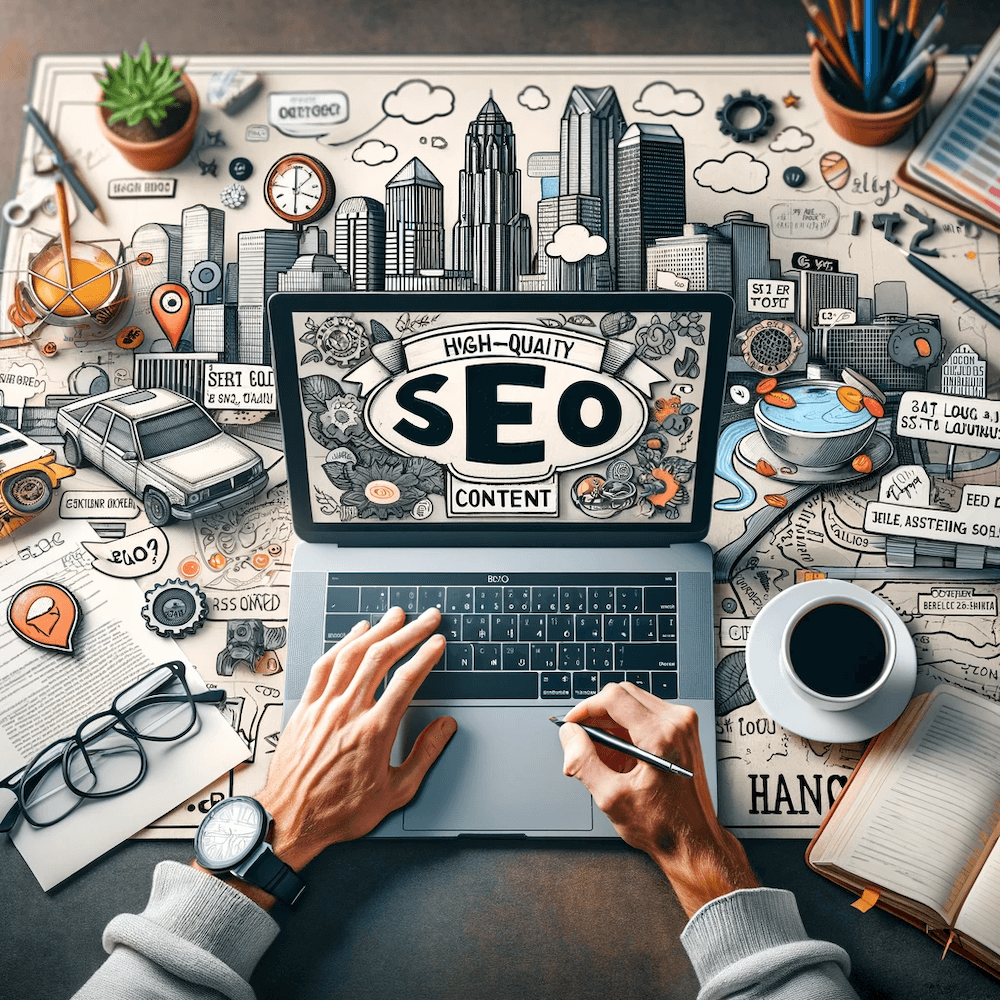Estimated reading time: 21 minutes
In the vibrant digital landscape of St. Louis, standing out online is not just a luxury – it’s a necessity. This is where On-Page SEO, a cornerstone of digital visibility, comes into play. But what exactly is On-Page SEO, and why is it crucial for local businesses in the Gateway City?
On-Page SEO Explained: At its core, On-Page SEO involves optimizing various elements of your website to improve its ranking in search engine results. This is not just about stuffing your site with keywords; it’s an art and science of making your website more attractive to search engines and users alike. From the words on your page to the way your images are tagged, every detail counts.
Related Links
Local Impact In St. Louis: For St. Louis businesses, mastering On-Page SEO means more than just online visibility; it’s about connecting with the local community. When someone searches for “best barbecue in St. Louis” or “St. Louis wedding photographer,” you want your business to be at the top of those search results. Effective On-Page SEO ensures your business is visible to those who are most likely to visit your store, use your services, and become loyal customers.
The Road Ahead: As we delve deeper into the world of On-Page SEO, we’ll explore key components that every St. Louis business owner should know. From keyword optimization to crafting compelling meta tags, from leveraging quality content to ensuring mobile-friendliness – each element plays a critical role in boosting your website’s search engine ranking. Whether you’re a bustling café in the Central West End, a trendy boutique in The Loop, or a professional service in Clayton, these On-Page SEO strategies are your ticket to standing out in the crowded digital space of St. Louis.
Join us as we navigate through the essentials of On-Page SEO, tailor-made for the unique market of St. Louis. It’s time to elevate your online presence and connect with the heart of your local audience.
Understanding Keywords – The Foundation Of Your SEO Strategy
The Importance Of Keyword Research
In the world of SEO, keywords are more than just words; they are the compass that guides potential customers to your St. Louis business. Keyword research is akin to conducting market research for your digital audience. It involves identifying the terms and phrases that potential customers are using to search for services or products like yours. For St. Louis businesses, this isn’t just about understanding what people are searching for, but also grasping how they are searching. Are they looking for “St. Louis pizza places” or “best pizza in STL”? Knowing this can make all the difference.
Tips For Finding Relevant Keywords
- Think Like A Local: Put yourself in the shoes of your potential customers. What local landmarks, neighborhoods, or colloquialisms might they use in their search queries? A person looking for a bookstore in St. Louis might search for “bookstores near Gateway Arch” or “book shops in The Hill.”
- Utilize Keyword Tools: Tools like Google Keyword Planner, SEMrush, or Ahrefs can provide insights into the search volume and competition for specific keywords. Use these tools to find a balance between highly searched terms and those with less competition.
- Analyze Competitors: Look at what keywords your competitors in St. Louis are targeting. This can give you an idea of what works in your market and how you can differentiate your strategy.
- Focus On Long-Tail Keywords: These are longer, more specific phrases that tend to have less competition. For example, instead of just “bakery,” target “artisan bread bakery in St. Louis.”
- Keep It Relevant And Varied: Ensure the keywords are relevant to your business. Also, use a variety of keywords, including both general and specific terms, to capture a wider audience.
Example: A St. Louis Bakery Targeting “Best Pastries in St. Louis”
Imagine you own a bakery in St. Louis, specializing in pastries. You might start by targeting a broad keyword like “bakery in St. Louis.” However, to hone in on your specialty and attract a more targeted audience, you might use specific keywords like “best pastries in St. Louis,” “French croissants in STL,” or “artisan pastries near Forest Park.”
By incorporating these keywords into your website’s content, meta tags, and even blog posts, you increase your chances of appearing in search results when locals or visitors search for the best pastries in town. Remember, it’s not just about getting traffic to your site; it’s about getting the right traffic – people who are looking exactly for what you offer.
In the next section, we will explore how to turn these keywords into engaging content that not only ranks well but also resonates with your St. Louis audience.

Crafting High-Quality Content – Engaging Your Audience And Search Engines
The Role Of Content In On-Page SEO
In the realm of On-Page SEO, content is king. It’s the vehicle that carries your keywords and delivers value to your audience. High-quality content not only engages your visitors but also signals to search engines that your website is a credible and valuable source of information. For businesses in St. Louis, this means creating content that resonates with the local audience while incorporating SEO strategies.
Strategies For Creating Engaging And SEO-Friendly Content
- Understand Your Audience: Know what your St. Louis audience is interested in. Are they looking for the best dining experiences, local event information, or professional services? Tailor your content to meet these interests.
- Incorporate Local Keywords Naturally: Weave your chosen keywords into your content in a way that feels natural and provides value. Overstuffing keywords can detract from the readability and quality of your content.
- Use A Variety Of Content Types: Mix up your content with blog posts, infographics, videos, and guides. For example, a video tour of St. Louis landmarks, or an infographic on the history of the city’s music scene.
- Focus On Quality And Value: Provide content that is informative, engaging, and valuable. This could be advice, insights, or entertaining content that speaks to your local audience.
- Optimize For User Experience: Ensure your content is easy to read and navigate. Use short paragraphs, headings, and bullet points to break up text and make it scannable.
Real-Life Example: A Local St. Louis Blog Post That Drives Traffic
Let’s take an example of a St. Louis real estate agency that created a blog post titled “The Ultimate Guide to Neighborhoods in St. Louis.” This comprehensive guide provided detailed information on various neighborhoods, covering aspects like history, demographics, lifestyle, and property types. By incorporating keywords like “St. Louis neighborhoods,” “living in St. Louis,” and “best St. Louis suburbs,” the agency was able to rank higher in search results.
The blog post was not just a list of places; it included personal stories, tips for home buyers, and insights into the local culture, making it engaging and valuable. By sharing the post on social media and local forums, the agency drove significant traffic to its website, attracting potential clients interested in buying property in St. Louis.
This example demonstrates that combining SEO strategies with quality, locally relevant content enables businesses to effectively engage their target audience and improve their online visibility.
In the next section, we will delve into optimizing meta tags to further enhance your website’s On-Page SEO.
Optimizing Meta Tags – Your Website’s First Impression
Understanding Title Tags And Meta Descriptions
Meta tags play a crucial role in On-Page SEO, acting as the first point of interaction between your website and potential visitors on search engine results pages (SERPs). Two key types of meta tags are the title tag and the meta description.
- Title Tag: This is the headline that appears in SERPs. It’s not only a ranking factor but also the first glimpse users get of your content. A well-crafted title tag can significantly impact click-through rates.
- Meta Description: This brief summary appears under the title tag in SERPs. While not a direct ranking factor, it influences user engagement by providing a snapshot of what your page offers.
Best Practices For Writing Effective Meta Tags With A Local Focus
- Incorporate Local Keywords: For businesses in St. Louis, including local keywords in your meta tags is essential. It helps in targeting local searches and appearing in relevant queries.
- Keep It Concise And Compelling: Title tags should be around 50-60 characters, and meta descriptions about 150-160 characters. Ensure they’re engaging and provide a clear value proposition.
- Reflect The Page Content: Your meta tags should accurately represent the content of the page. Misleading tags can lead to high bounce rates, negatively impacting your SEO.
- Use Unique Tags For Each Page: Each page on your website should have unique meta tags that reflect its specific content, especially important for businesses with multiple services or locations.
- Include A Call To Action: Encourage clicks by including a compelling call to action (CTA) in your meta description.
Example: Meta Tags For A St. Louis Real Estate Website
Let’s consider a St. Louis real estate website optimizing its homepage meta tags:
- Title Tag: “Top St. Louis Real Estate Agents – Find Your Dream Home in STL”
- Meta Description: “Discover premier properties in St. Louis with our expert real estate agents. Browse listings in the best neighborhoods and find your dream home in the heart of STL. Contact us today!”
In this example, the title tag incorporates a local keyword (“St. Louis Real Estate Agents”) and is concise yet informative. The meta description gives a brief overview of the services, includes a local focus (“properties in St. Louis”), and ends with a clear CTA.
By strategically crafting your meta tags with a local focus, you can significantly enhance your visibility in local searches, attract more targeted traffic, and make a strong first impression on potential customers searching for services in St. Louis.
In the next section, we will explore the importance of header tags in structuring your content effectively for both users and search engines.

Utilizing Header Tags – Structuring Your Content For Success
The Importance Of Header Tags For SEO And Readability
Header tags, ranging from H1 to H6, are vital for both search engine optimization (SEO) and enhancing the readability of your website’s content. They serve two primary functions:
- SEO: Header tags help search engines understand the structure and hierarchy of your content, making it easier for them to index and rank your pages effectively.
- Readability: For users, these tags break down content into digestible sections, improving the overall user experience and keeping readers engaged.
Effectively Using H1, H2, and H3 Tags with Local Keywords
- H1 Tags: Every page should have one H1 tag, usually the title of the page. It’s the most significant header and should contain your primary keyword. For a local focus, include a keyword specific to St. Louis.
- H2 Tags: These are used for main section headings and should incorporate secondary keywords. They help in further organizing content and can include more specific local phrases.
- H3 Tags: Use these for sub-sections under your H2 tags. They can be more detailed and targeted, using long-tail local keywords relevant to St. Louis.
Case Study: A Successful St. Louis Small Business Website
Consider a local café in St. Louis, “The Gateway Grind,” which revamped its website with the effective use of header tags:
- H1 Tag: “Welcome to The Gateway Grind – Your Cozy St. Louis Café”
- H2 Tags: “Our Menu – Featuring Locally-Sourced Ingredients,” “Events at The Gateway Grind,” “Visiting St. Louis? Stop by Our Café!”
- H3 Tags: Under the “Events at The Gateway Grind” section, they used H3 tags like “Live Music Nights,” “St. Louis Art Showcases,” and “Coffee Tasting Events.”
By incorporating keywords like “St. Louis Café” in the H1 tag, the café established its main focus. The H2 and H3 tags not only provided structure but also included keywords relevant to their offerings and local events, enhancing their visibility for searches related to café experiences in St. Louis.
After implementing these changes, The Gateway Grind saw an increase in website traffic, particularly from searches related to local events and dining options in St. Louis. This case study illustrates how well-structured header tags, combined with local SEO strategies, can significantly impact a small business’s online presence and attract more local customers.
In the next section, we’ll explore how optimizing images on your website can further enhance your SEO efforts and user experience.
Image Optimization – Enhancing Performance And Engagement
The Impact Of Images On Page Load Time And User Experience
Images are a critical component of any website, adding visual appeal and aiding in storytelling. However, they also have a significant impact on page load times, which can affect both user experience and SEO rankings. Slow-loading pages can lead to higher bounce rates and lower user engagement, while fast-loading pages are favored by search engines and users alike.
Best Practices For Optimizing Images
- Optimize Image File Size: Large images can drastically slow down your website. Use tools like Adobe Photoshop, GIMP, or online compressors to reduce file size without compromising quality.
- Choose The Right Format: JPEG is ideal for photographs, PNG for images with transparency, and SVG for logos and icons. Each format offers different benefits in terms of quality and file size.
- Use Descriptive Alt Text: Alt text improves accessibility and SEO. It should accurately describe the image and include relevant keywords, especially local ones for St. Louis-based businesses.
- Responsive Images: Ensure your images look good on all devices. Use HTML and CSS techniques to make images responsive, adapting to different screen sizes and resolutions.
- Leverage Lazy Loading: This technique loads images only as they are about to enter the viewport, reducing initial load time and improving user experience.
Example: Before And After Of A Local Restaurant’s Website
Before Optimization: A St. Louis restaurant, “River City Eats,” had a website rich in high-quality images. However, these images were large in file size, leading to a webpage that loaded slowly. The lack of alt text and non-responsive images also impacted user engagement and SEO performance.
After Optimization:
- Reduced File Sizes: The restaurant’s website images were compressed, reducing the file sizes by over 50% without losing visual quality.
- Improved Alt Text: Each image was given descriptive alt text, like “Gourmet St. Louis BBQ Ribs,” enhancing SEO and accessibility.
- Responsive Design: The images were coded to be responsive, ensuring they looked good on both desktop and mobile devices.
- Implemented Lazy Loading: This reduced the initial load time, making the website faster and more user-friendly.
Post-optimization, “River City Eats” saw a significant decrease in page load times and an increase in page views and user engagement. Their improved SEO also led to better search engine rankings for local restaurant searches in St. Louis.
In the next section, we will explore the importance of mobile optimization in the modern SEO landscape, a crucial element for reaching the tech-savvy St. Louis audience.

Mobile Optimization – Catering To The On-The-Go Audience
The Importance Of A Mobile-Friendly Website For Local SEO
In today’s fast-paced world, mobile devices dominate internet usage. For local businesses in St. Louis, having a mobile-optimized website is no longer optional; it’s essential. Mobile optimization affects not only user experience but also plays a significant role in SEO. Search engines like Google prioritize mobile-friendly websites in their rankings, especially after the implementation of mobile-first indexing. For local businesses, this means that a mobile-optimized site is crucial for appearing in searches made by potential customers on the move in St. Louis.
Tips For Ensuring Your Website Is Mobile-Responsive
- Responsive Design: Ensure your website adjusts seamlessly to fit the screens of various devices, from desktops to smartphones. This involves using flexible layouts, images, and cascading style sheets (CSS).
- Fast Loading Speed: Mobile users expect quick access to information. Optimize your website’s loading speed by compressing images, leveraging browser caching, and minimizing code.
- Simplify Navigation: Mobile screens are smaller, so it’s essential to have a simple, easy-to-navigate website layout. Consider a hamburger menu for compact navigation.
- Touch-Friendly Design: Design your website with touch in mind. Buttons and links should be easily clickable, and forms should be simple to fill out on mobile devices.
- Avoid Flash: Use HTML5 instead of Flash, as Flash is not supported on most mobile devices and can hinder your website’s performance and SEO.
- Test Your Site: Use tools like Google’s Mobile-Friendly Test to check how well your website performs on mobile devices and identify areas for improvement.
Example: A St. Louis Service Provider’s Mobile Site Transformation
Before Optimization: A St. Louis-based HVAC service, “Gateway Comfort Systems,” had a website that was not optimized for mobile devices. The site’s layout was cluttered on smaller screens, the text was difficult to read, and the loading times were slow on mobile devices.
After Optimization:
- Responsive Design: The website was redesigned with a responsive layout, ensuring it adapted smoothly to different screen sizes.
- Improved Loading Speed: Images were compressed, and the code was optimized to enhance loading speed on mobile devices.
- Streamlined Navigation: A simplified navigation menu was implemented, making it easy for mobile users to find information.
- Touch-Friendly Elements: Buttons and form fields were resized for easier interaction on touchscreens.
- Flash Removal: All Flash elements were replaced with HTML5, ensuring compatibility across all mobile devices.
After these changes, “Gateway Comfort Systems” experienced a significant increase in mobile traffic and higher engagement rates. Their improved mobile presence also led to better local search rankings, making them more visible to potential customers in St. Louis searching for HVAC services on their smartphones.
In the next section, we will delve into the importance of internal linking, a key factor in enhancing user experience and boosting your SEO efforts.
Internal Linking – Enhancing Navigation And SEO
How Internal Linking Helps With Site Navigation And SEO
Internal linking is the process of linking one page of your website to another page within your website. This strategy is a powerhouse in both aiding site navigation and bolstering your SEO efforts.
For Site Navigation: Internal links help users easily navigate your website, leading them to relevant information and encouraging them to spend more time exploring your content. This improved user engagement signals to search engines that your site is valuable, which can boost your rankings.
For SEO: Internal links help search engines understand the structure and hierarchy of your website. By using clear and descriptive anchor text, you can show how different pages are related and which pages are most important.
Strategies For Effective Internal Linking
- Use Descriptive Anchor Text: Instead of generic phrases like “click here,” use anchor text that describes the linked page. This improves user experience and helps search engines understand the context of the link.
- Link To Relevant Content: Ensure the pages you’re linking are relevant to each other. This not only helps SEO but also keeps users engaged with your content.
- Don’t Overdo It: While internal linking is beneficial, too many links on a page can be overwhelming. Aim for a balance that feels natural and helpful to the user.
- Link High-Value Pages: Use internal links to direct users to your most important pages, like those that convert visitors into leads or customers.
- Regularly Update Internal Links: As you add new content to your website, revisit your older pages to add links to the new content where relevant.
Case Example: A St. Louis Law Firm’s Website Navigation
Before Optimization: A law firm in St. Louis, “Gateway Legal Services,” had a website with minimal internal linking. This lack of internal links led to a disjointed user experience and underperformance in SEO.
After Optimization:
- Homepage Links: The firm added links on its homepage to key practice areas, making it easier for visitors to find relevant services.
- Blog Post Links: In their blog posts, they began linking to related articles and their service pages. For instance, a blog post about estate planning included a link to their “Estate Planning Services” page.
- Footer Links: The footer was optimized to include links to important pages like ‘Contact Us’, and ‘About Us’, and their different legal services.
As a result of these changes, “Gateway Legal Services” saw an increase in page views per session and a decrease in bounce rate. Their SEO rankings improved due to better site structure and increased page authority, making them more visible to potential clients searching for legal services in St. Louis.
In the next section, we’ll explore how local SEO factors specifically impact St. Louis businesses and how to leverage them for maximum visibility.

Local SEO Factors – Boosting Your St. Louis Business’s Online Presence
Specific Considerations For St. Louis Businesses
Local SEO is a game-changer for businesses targeting a specific geographic area. For St. Louis businesses, local SEO ensures that your website shows up in search results when potential customers in the area are looking for services or products you offer. This involves optimizing your online presence not just for what you do, but also for where you do it.
Importance Of Local Schema, Google My Business, And Local Backlinks For On-Page SEO
- Local Schema: Implementing local schema markup on your website is like giving search engines a roadmap of your business’s local details. This code helps search engines understand your business location, hours, and services, which can enhance your visibility in local search results.
- Google My Business (GMB): A well-optimized GMB profile is essential. It allows you to appear in local search results and Google Maps, providing potential customers with easy access to your business information, reviews, and location.
- Local Backlinks: Backlinks from local sources (like St. Louis business directories, local news websites, or community blogs) signal to search engines that your business is relevant and prominent in the local community.
Example: A Local Café’s Rise In Local Search Rankings
Before Optimization: “Bean There, Brewed That,” a cozy café located in the heart of St. Louis, struggled with online visibility. Despite offering a great ambiance and quality coffee, they weren’t appearing in local search results.
After Implementing Local SEO Strategies:
- Local Schema: They added local schema markup to their website, including their cafe’s address, hours, and menu items.
- Optimized Google My Business: They claimed and optimized their GMB listing, ensuring all information was up-to-date, and actively encouraged customers to leave reviews.
- Local Backlinks: The café participated in local events and collaborated with a St. Louis food blogger, gaining backlinks from local websites and blogs.
As a result, “Bean There, Brewed That” experienced a significant increase in online visibility. They started appearing in top search results for “cafes in St. Louis” and “best coffee in St. Louis,” leading to increased foot traffic and higher sales.
Local SEO is a powerful tool when mixed with on-page SEO for St. Louis businesses. By focusing on local schema, Google My Business, and garnering local backlinks, businesses can significantly improve their local search rankings and visibility.
Conclusion: Elevating Your St. Louis Business with On-Page SEO
As we wrap up this comprehensive guide to On-Page SEO optimization, let’s revisit the key strategies that can propel your St. Louis business to new heights in the digital realm. By understanding and implementing these SEO tactics, you’re not just improving your website; you’re opening the door to a world of opportunities in the bustling online marketplace of St. Louis.
Key Points Recap For On-Page SEO:
- Understanding Keywords: Start with thorough keyword research, focusing on terms relevant to both your industry and the St. Louis area.
- Crafting High-Quality Content: Develop engaging, informative content that resonates with your audience and utilizes your target keywords.
- Optimizing Meta Tags: Create compelling and concise title tags and meta descriptions with a local focus.
- Utilizing Header Tags: Structure your content effectively using header tags, incorporating local keywords for better SEO.
- Image Optimization: Ensure your images are optimized in terms of file size and include descriptive alt text.
- Mobile Optimization: Make your website mobile-friendly to cater to the growing number of users accessing the web via mobile devices.
- Internal Linking: Use internal linking wisely to enhance site navigation and SEO.
- Local SEO Factors: Leverage local schema, Google My Business, and local backlinks to boost your local presence.
Each of these elements plays a crucial role in ensuring that your website not only ranks well in search engines but also truly connects with the St. Louis community. Whether you’re a start-up café, an established law firm, or a burgeoning retail outlet, these SEO strategies are your toolkit for online success.
A Call To Action For St. Louis Businesses: Now is the time to take action. Implementing these On-Page SEO strategies can be the difference between being a hidden gem and becoming a go-to destination in St. Louis. However, we understand that SEO can be complex and time-consuming.
Need Professional SEO Assistance? At [Your Company Name], we specialize in elevating businesses like yours through tailored SEO strategies. Our expertise in On-Page SEO, combined with a deep understanding of the St. Louis market, positions us uniquely to help you achieve your digital marketing goals.
Get In Touch For A Consultation Don’t let your business get lost in the digital shuffle. Contact us today for a consultation, and let’s start the journey of transforming your online presence. Together, we can ensure that your business not only survives but thrives in the competitive online landscape of St. Louis.
Additional Resources: Further Your SEO Knowledge And Expertise
To continue your journey in mastering On-Page SEO and enhancing your St. Louis business’s online presence, we’ve compiled a list of valuable resources and tools. These resources will provide deeper insights into SEO strategies and best practices, helping you stay ahead in the ever-evolving world of digital marketing.
Recommended Reading And Tools for On-Page SEO
- Google’s Search Engine Optimization (SEO) Starter Guide: A comprehensive guide from Google itself, perfect for understanding the basics of SEO.
- Moz Blog: Offers a wealth of articles and guides on various aspects of SEO, ideal for both beginners and seasoned marketers.
- SEMrush Academy: Provides free courses and resources on SEO, including keyword research and content optimization.
- Ahrefs Blog: Offers in-depth articles and tutorials on improving your website’s SEO.
- Yoast SEO Blog: Great for learning about WordPress SEO and content optimization.
- Google Analytics: Essential for tracking your website’s performance and understanding user behavior.
- Google Search Console: A tool to monitor, maintain, and troubleshoot your site’s presence in Google Search results.
Get Personalized SEO Guidance In St. Louis From Matchbox Design Group
If you’re looking for tailored advice and strategies specific to your St. Louis business, our team at Matchbox Design Group is here to help. We offer personalized SEO consulting and services to ensure your business not only ranks higher in search results but also connects effectively with your local audience.
Contact Us Today:
- Phone: 314-849-6969
- Email: Contact Us Here
- Contact: Use Our Contact Page
Feel free to reach out for a detailed discussion on how we can assist in boosting your online presence and driving more traffic to your website. Let’s collaborate to make your St. Louis business a standout success in the digital world!
Contact Matchbox Design Group Today!
If your website could use a refresh, if you’re looking to drive more traffic to your site, or you would like to submit a guest post, fill out the form below and we’ll contact you to learn more about your digital needs.
